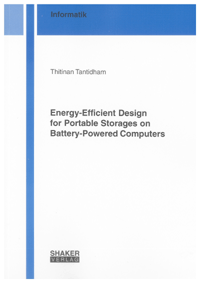
Reviews
Reviews

Thitinan Tantidham
Energy-Efficient Design for Portable Storages on Battery-Powered Computers
Review
This thesis focuses on energy efficiency design for different storage characteristics, e.g. between an internal-storage drive of a laptop computer and a portable-storage device. It studies the characteristics of battery packs and their lifetime by observing multiple systems. Furthermore, battery discharge models have been analyzed based on system utilization in terms of CPU utilization, frequency, and voltage considering CMOS power consumption basis and using regression method analysis. The accuracy of the model is dependent on regression coefficients, the measurement techniques due to instability of battery discharge rate and capacity, and the profile workloads. The proposed models are flexible to be applied to different systems with the available or unavailable value of the present rate provided by the smart battery. They can be used to estimate the remaining battery lifetime by giving the system utilization information. By developing time series models like moving average techniques, they can be used to estimate the battery lifetime together with the present rate given by the smart battery. Furthermore, the portable storage system architecture and characteristics of portable flash and magnetic disk storages are investigated. I/O workloads of portable storages can be classified into two categories: file transfer and data-access operation. A file transfer represents data backup applications or any long data transfer between a portable and a local storage drive. A data-access operation is intended for a portable application, an accessed file, or a database file, which requires a small number of I/O operations. The evaluation methodologies in the file system level for these two workloads have been observed by measurements, without description of hardware characteristics. The results reveal that flash storages provide better energy efficiency on a read file transfer in small file sizes as well as a random read access and a synchronous write access for small request sizes than disk storages do. Since the flash storages have higher cost per bit than the hard-disk storages and a finite number of erase-write cycles, they are better for allocating read-only files. On the contrary, the disk storages outperform the flash storages for write operations, especially on a large file transfer, but their power consumption and performance highly depend on the spinning rate. Finally, the framework for power-aware data allocation management between a portable and a hard disk drive in the context of energy efficiency has been proposed. This framework supports two phases of power supply: AC or battery. In an AC power phase, storage maintenance operations, such as data defragmentation, virus scanning, software installation, backup, and file allocation, should be performed. As the file access patterns, by means of read- to-write ratio, random-to-sequential ratio, and I/O request size, are dependent on the applications and dynamic upon user access behaviors, the graphs with a mixture of different access patterns support the file-allocation making-decision schemes. In a battery-power phase, in order to maintain data service continuation during laptop´s battery exhaustion, data synchronization and backup from the local storage to the portable storage is periodically scheduled upon the specified failure rate, the remaining battery capacity, the file size, and the portable storage characteristics. (orig.)
Am Langen Graben 15a
52353 Düren
Germany
Fri. 8:00 a.m. to 3:00 p.m.

